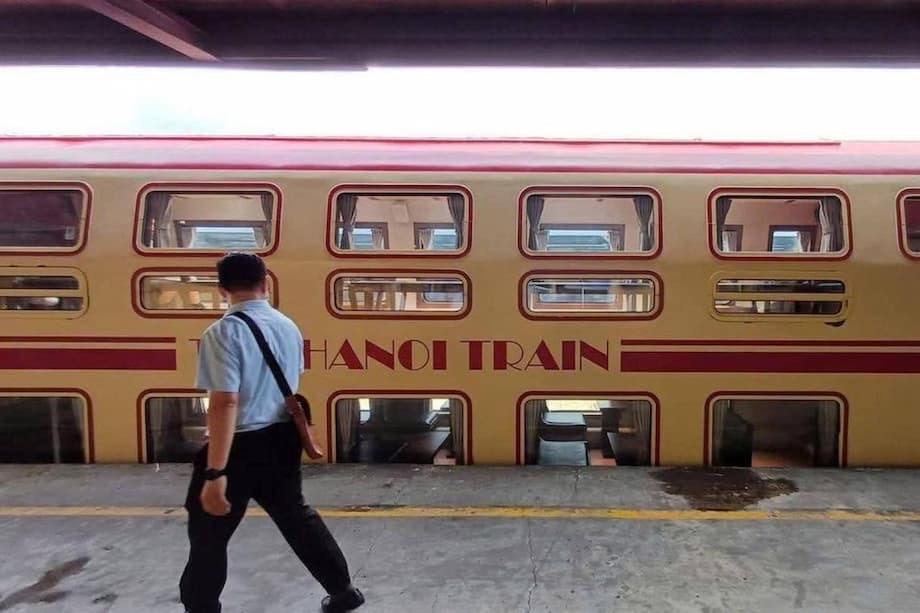A new way to see the capital
Hanoi has launched a new attraction on rails, and it is built around culture as much as movement. On September 6, the Hanoi Train began official service, carrying visitors from Hanoi Station to Tu Son in Bac Ninh Province with live music, craft demonstrations, and classic flavors served in comfortable double decker carriages. The project is a collaboration between the Vietnam Railway Corporation and BHL Tourism Service Trading Joint Stock Company. It is designed to reintroduce the railway into city life, connect the capital with the Kinh Bac cultural region, and give travelers a curated introduction to traditions that shaped northern Vietnam.
- A new way to see the capital
- What makes this journey different
- Design with a story, drawn from Hanoi’s five gates
- Routes, timetable and tickets
- From Long Bien Bridge to Do Temple
- Part of a larger push to make rail a cultural draw
- How it fits beside Hanoi Train Street and Vietnam’s rail appeal
- Practical tips for travelers
- Quick Facts
The concept is simple to grasp. Instead of a standard point to point commuter service, this is a short cultural journey. Two trains depart daily from Hanoi Station via Gia Lam and Yen Vien to Tu Son Station and then return to the capital. Morning and early afternoon departures are set at 8:00 AM and 1:30 PM, with arrivals at 8:41 AM and 2:32 PM. In the opposite direction, trains leave Tu Son at 10:30 AM and 4:20 PM and arrive back at Hanoi Station at 11:33 AM and 5:00 PM. Passengers are encouraged to check in 30 minutes before departure. On board, a program of music and craft activities unfolds as the city gives way to the Red River corridor and the heritage sites of Bac Ninh.
The train’s design ties the ride to local history. The interiors take inspiration from Thang Long, the ancient citadel that stood at the heart of the capital for centuries. Carriages carry names of the five historic city gates, known locally as O Cau Den, O Quan Chuong, O Cau Giay, O Cho Dua, and O Dong Mac. Inside, passengers find themed decor, panoramic windows for viewing, and comfortable seating for 40 to 60 guests per carriage. The service currently uses five double decker seating carriages and two check in carriages that double as photo friendly spaces. Tickets are priced from 550,000 to 750,000 Vietnamese dong, with discounts for children and groups. Bookings can be made at Vietnam Railways counters at Hanoi Station, through travel agents, or online, including the line’s site at hanoitrain.vn.
What makes this journey different
Vietnam has a long tradition of making rail travel social and unhurried. This new service builds on that spirit and turns a short regional ride into a compact performance space. Instead of passing through the countryside in silence, travelers hear the songs of Kinh Bac, watch artists work, and sample the foods that define the season in Hanoi. The result feels closer to a festival carriage than a standard coach. It is a curated taste of culture, and it takes place as the scenery slides by.
Live heritage performances on board
The program highlights heritage from northern Vietnam. Performers bring quan ho (love duet folk singing), cheo (traditional opera), ca tru (ceremonial chamber singing), and xam (a street ballad tradition associated with blind buskers) to life in the aisles. These traditions carry different rhythms and histories. Quan ho, rooted in Bac Ninh, is a call and response duet with harmonies shared by paired singers. Cheo blends song and theater with gestures that predate modern stage forms. Ca tru features a female lead vocalist accompanied by a lute and rhythmic clappers, and once flourished in royal and scholarly circles. Xam emerged from street performance and remains direct and vivid. The on board program introduces each style in short segments that are easy to appreciate even if it is a first encounter.
Food and craft activities from Hanoi and Kinh Bac
Between songs, passengers see and try crafts. Simple hands on activities include making elements of Dong Ho folk painting, a tradition from a village near Bac Ninh known for woodblock prints in bright natural colors. There are also quick demonstrations of Phu The cakes, sometimes called husband and wife cakes, a ceremonial sweet associated with weddings in the region. The culinary menu leans into Hanoi’s seasonal tastes. Green young sticky rice, known locally as com, and lotus scented tea are served, alongside light snacks that change with the harvest. These details underscore that the train is selling a sense of place as much as a scenic seat.
Design with a story, drawn from Hanoi’s five gates
The train’s visual identity draws from the five gates that once guarded the old city. O Quan Chuong, with its distinctive arched entrance, still stands on the eastern edge of the Old Quarter. O Cau Giay and O Dong Mac evoke the outer approaches to the citadel that protected the capital. O Cho Dua and O Cau Den reference bustling market districts and the everyday life that surrounded the ancient walls. Carriages reinterpret these gate motifs through patterned tiles, wooden surfaces, classic signage, and stylized references to Long Bien Bridge and the Red River. The aim is not to recreate a museum carriage, but to spark recognition and curiosity while keeping modern comforts front and center.
Some carriages include dedicated spaces for photos, a nod to the check in culture that powers much of modern travel. Wide windows invite shots of the Red River banks and rice fields. The visual story links the capital’s identity with the Kinh Bac countryside, and it gives travelers a consistent theme from platform to platform.
Routes, timetable and tickets
At launch, the core service is a short run from Hanoi Station to Tu Son in Bac Ninh Province and back. The official timetable lists two daily departures from Hanoi, with morning and early afternoon rides, and two returns from Tu Son. Scheduled travel time is just over 40 minutes each way, which leaves enough room for a compact performance and a tasting menu without overstaying. The line passes via Gia Lam and Yen Vien before reaching Tu Son.
City and operator communications also describe an expanded plan that includes three departures a day and a special evening run that loops around the city, with views of Hanoi after dark. Some guides mention a longer scenic itinerary with more time on the rails, and a route that crosses Long Bien Bridge. The exact run can vary by operating phase. Travelers should confirm the latest schedule and route pattern when booking, and plan according to the selected departure.
Tickets can be purchased at Vietnam Railways counters at Hanoi Station, via partner travel agencies, and online channels. The published price range is from 550,000 to 750,000 Vietnamese dong per passenger, depending on seating and service tier, with promotions for children and groups. Seats are arranged in themed sections. Upper deck window seats tend to be the favorite for photographers. Arrive 30 to 45 minutes early to complete check in and enjoy the pre departure activities. For the most current departures and booking options, check the operator’s site at hanoitrain.vn or inquire at the station.
From Long Bien Bridge to Do Temple
One highlight of any rail trip from Hanoi is the approach to Long Bien, the historic cantilever bridge designed at the start of the twentieth century. The bridge carries rail and road traffic across the Red River and remains a symbol of Hanoi’s resilience. On certain runs and future evening loops, the train pairs its cultural program with river views and the switch from city streets to farmland within a few minutes. The visual contrast is part of the story that the service wants to tell.
The destination at Tu Son opens a different chapter. Bac Ninh is the homeland of quan ho and a center of the Kinh Bac cultural region. A short transfer from the station brings visitors to Do Temple, a complex dedicated to eight kings of the Ly dynasty. The Ly line moved the capital to Thang Long in 1010 and set the shape of the city that became modern Hanoi. At the temple, visitors learn how court culture, Buddhism, and river trade shaped this region. Many tours link the temple visit with stops at craft villages and pagodas. The combination of rail travel and heritage sites makes a compact day trip that fits well into a Hanoi itinerary.
Do Temple also helps explain why the on board program leans toward traditions like quan ho. The music echoes across the Kinh Bac countryside at spring festivals, and it is easier to appreciate when heard in the place that nurtured it. Pairing the performance with a visit to the temple grounds closes the loop between stage and site.
Part of a larger push to make rail a cultural draw
Hanoi’s tourism planners have been looking at rail as a stage and a connector, not just a way to move people. The Department of Tourism and Vietnam Railways have surveyed inner city and suburban heritage routes that link stations such as Hanoi, Long Bien, Gia Lam, and Co Loa. Ideas include turning stations into cultural spaces with performances and exhibitions, aligning stop times with museum hours, and creating a railway museum at the Gia Lam Train Factory. These proposals point to a network of short rail experiences that would make it easier for visitors to sample culture along the tracks.
The city has also packaged experiences for the festival season in a program called 80 Golden Experiences in Hanoi. The new tourist train is one of the headline items. Another is a Metro Green Journey built around the Cat Linh to Ha Dong urban railway, which pairs metro rides with stops at Van Phuc Silk Village, the Temple of Literature, and a visit to a depot with an interactive train simulation. The goal is to make public transport part of the itinerary, not a hurdle to reach it.
Modernization is happening behind the scenes too. On August 19, Hanoi Station began operating a biometric ticket control system that checks a traveler’s identity through the national ID database. Early trials reduced verification times to a few seconds per passenger and improved accuracy. Integration with the VNeID app is planned so that a phone can be used for ID verification. The rollout shows how the sector is working to improve service quality while adding creative products like the heritage train.
How it fits beside Hanoi Train Street and Vietnam’s rail appeal
Many visitors know Hanoi’s rail scene because of Train Street, a narrow stretch of track that squeezes past cafes and homes in the Old Quarter. It is an eye catching place to watch a locomotive slide by at slow speed. The area’s popularity has also brought safety concerns and periodic closures by city authorities. Local businesses and visitors are urged to follow instructions from guards and only access sections that are open to the public. The new heritage train offers a different way to connect with rail culture. It is structured, ticketed, and designed for safe interaction with songs and crafts on board, rather than a rush of adrenaline at trackside.
Beyond Hanoi, train travel in Vietnam remains a favorite way to see the country. Long distance trains like the service often called the Reunification Express between Ho Chi Minh City and Hanoi move through coastal plains, passes, and rice fields with a social rhythm that is hard to find on highways or flights. Dining cars, snack trolleys, and seat side chats make the journey part of the holiday. The Hanoi Train taps into that spirit, in miniature, and points it at the specific heritage of Thang Long and Kinh Bac.
Practical tips for travelers
Planning a ride on the Hanoi Train is straightforward, and a little preparation makes it even more rewarding. Consider the following suggestions before you book and board.
- Book early for morning departures, which are popular for sightseeing at Tu Son and Do Temple.
- Arrive 30 to 45 minutes before departure to complete check in and enjoy pre departure activities at the platform.
- Pick an upper deck window seat if photography is a priority, and keep your camera ready when the train runs along the Red River corridor.
- Bring small bills for snacks and crafts, and try lotus scented tea and seasonal com while on board.
- Use the on board time to listen and watch. Performances are short so each tradition gets a moment of focus.
- Check the latest timetable on the official site and confirm whether your departure is a Tu Son run or an evening loop around the city.
- At Tu Son, plan a visit to Do Temple and nearby craft villages. Guided tours can save time if your schedule is tight.
- For Train Street, follow official guidance and stay behind safety lines. Enjoy the new heritage train if you want a controlled, culture forward rail experience.
Quick Facts
- The Hanoi Train launched on September 6 with a short cultural journey between Hanoi Station and Tu Son in Bac Ninh.
- Two daily departures from Hanoi are scheduled at 8:00 AM and 1:30 PM, with returns from Tu Son at 10:30 AM and 4:20 PM.
- On board programs feature quan ho, cheo, ca tru, and xam performances, plus craft demos and Hanoi seasonal dishes.
- Carriages are themed after the five historic gates of Thang Long and include double decker seating with panoramic windows.
- Tickets cost from 550,000 to 750,000 VND, with discounts for children and groups. Booking is available at Hanoi Station, via agents, and online.
- At Tu Son, visitors can tour Do Temple, dedicated to eight kings of the Ly dynasty, and explore Kinh Bac cultural sites.
- City plans include additional heritage routes, cultural station spaces, and a future railway museum at the Gia Lam Train Factory.
- Hanoi Station is piloting biometric ticket checks that verify identity in seconds and will link with the VNeID app.
- The new train complements, rather than replaces, Hanoi Train Street, providing a curated and safer way to experience rail culture.




